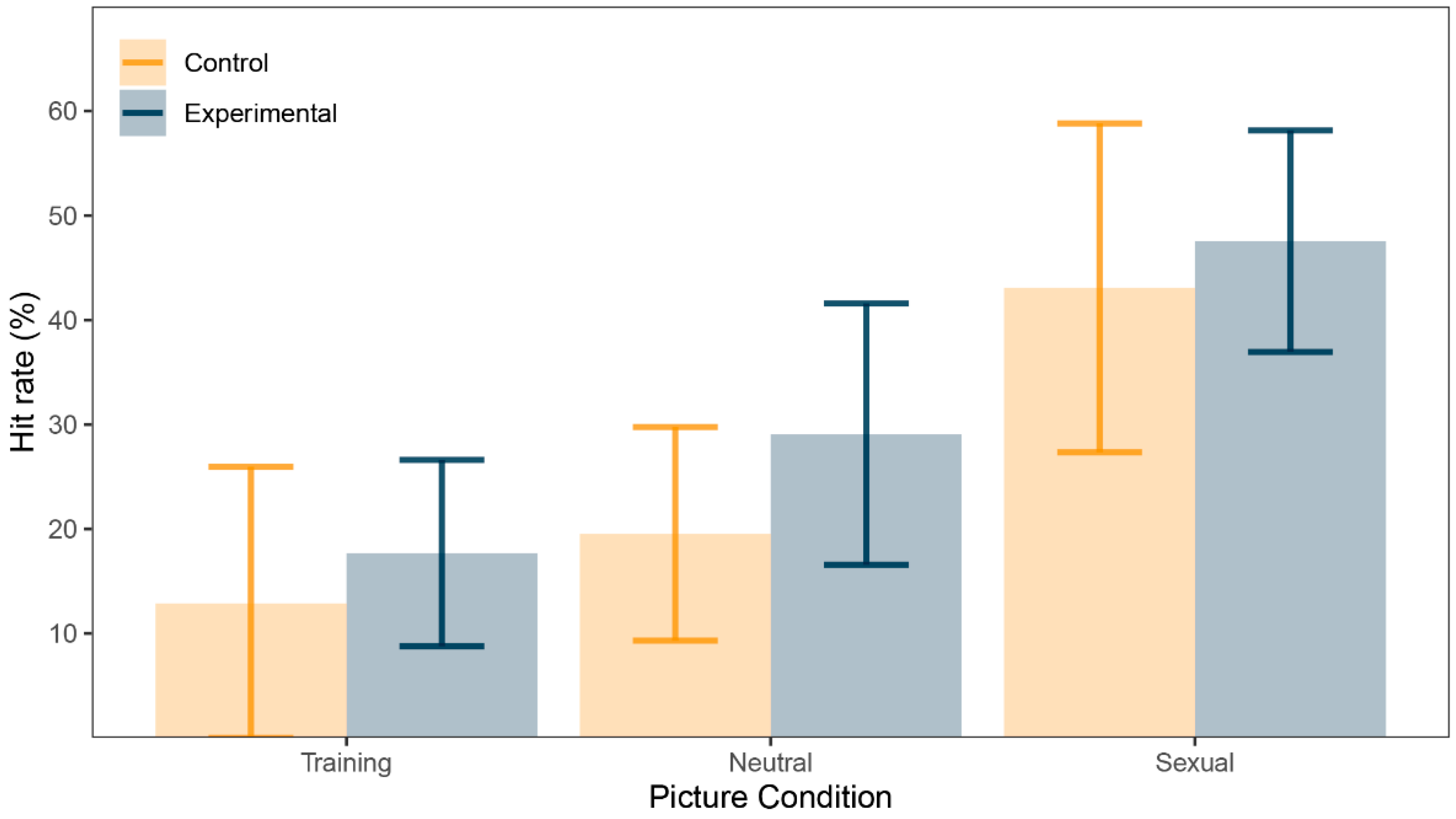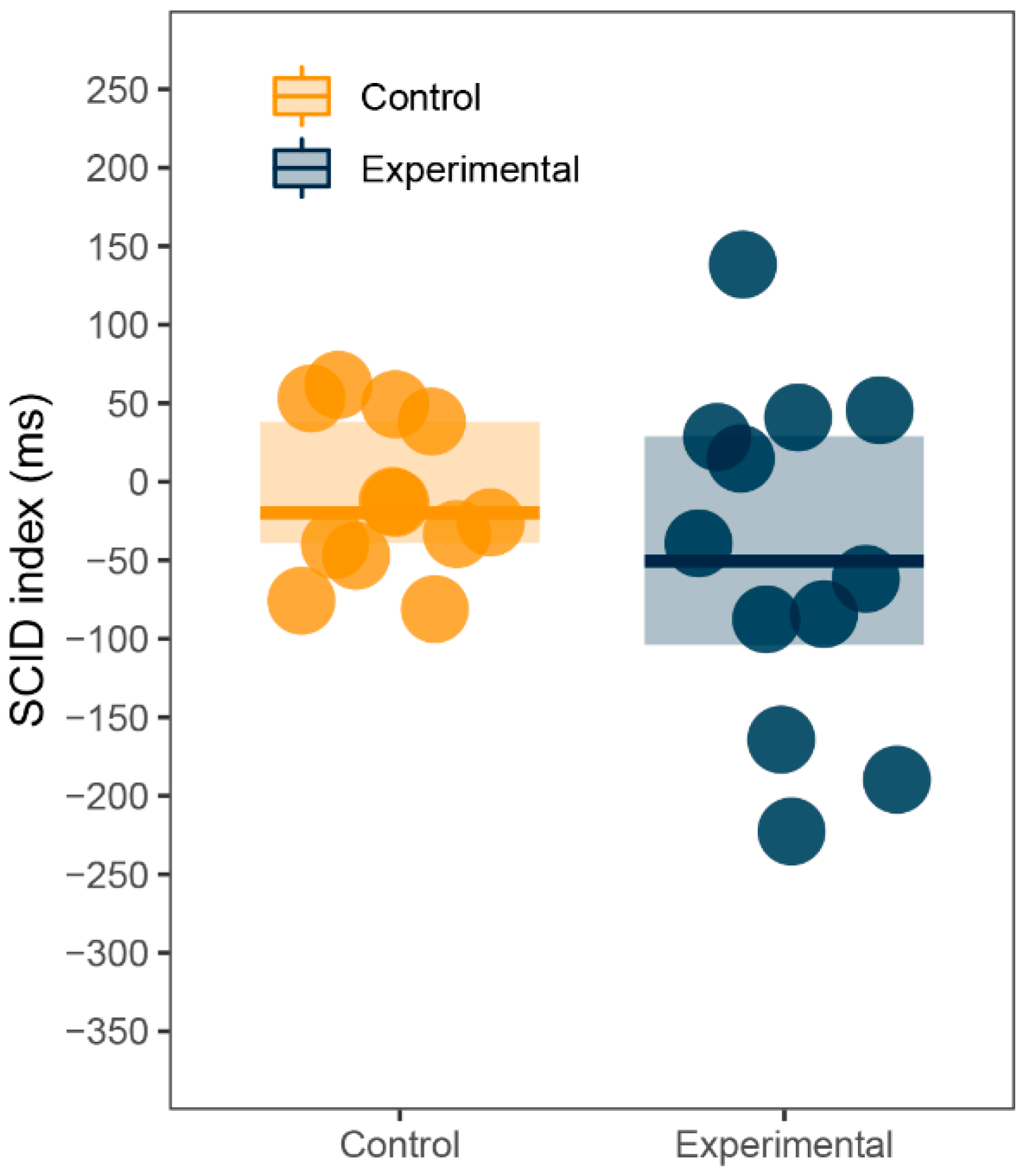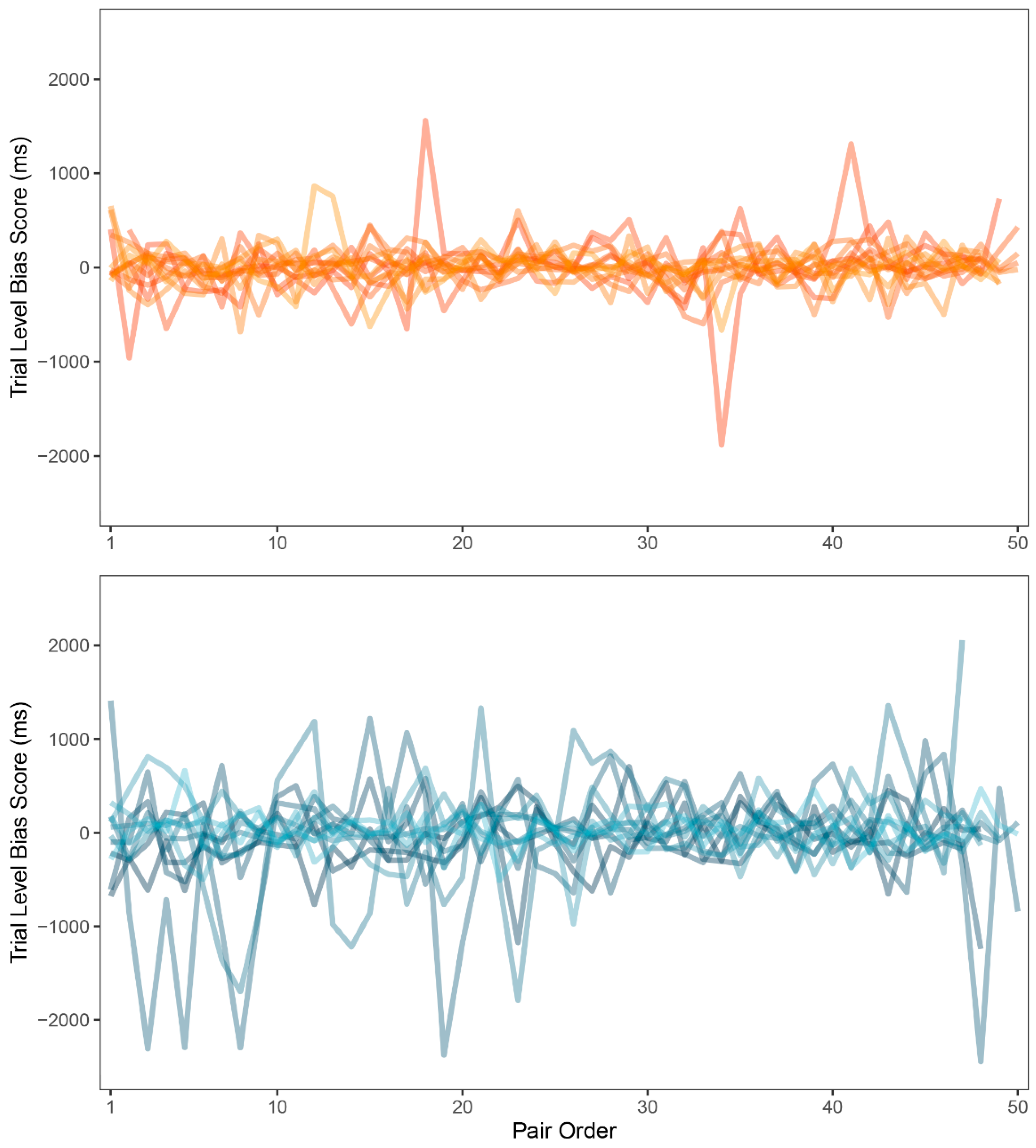Attention Bias and Recognition of Sexual Images in Depression
Abstract
:1. Introduction
2. Materials and Methods
2.1. Participants
2.2. Measures
2.2.1. Dot-Probe Task
2.2.2. Picture Recognition Task
2.2.3. Questionnaires
2.3. Materials
2.4. Procedure
2.5. Ethics Statement
2.6. Data Analysis
3. Results
3.1. Dot-Probe Task
3.2. Picture Recognition Task
3.3. SIS/SES and Associations with AB Index
3.4. Explorative Analyses
3.4.1. SCID Effect
3.4.2. Trial-to-Trial Performance
3.4.3. Trial Level Bias Score Indexes
4. Discussion
5. Conclusions
Author Contributions
Funding
Institutional Review Board Statement
Informed Consent Statement
Data Availability Statement
Acknowledgments
Conflicts of Interest
References
- Liu, Q.; Zhang, Y.; Wang, J.; Li, S.; Cheng, Y.; Guo, J.; Zhu, Z. Erectile dysfunction and depression: A systematic review and meta-analysis. J. Sex. Med. 2018, 15, 1073–1082. [Google Scholar] [CrossRef]
- Atlantis, E.; Sullivan, T. Bidirectional association between depression and sexual dysfunction: A systematic review and meta-analysis. J. Sex. Med. 2012, 9, 1497–1507. [Google Scholar] [CrossRef]
- Frohlich, P.; Meston, C. Sexual functioning and self-reported depressive symptoms among college women. J. Sex Res. 2002, 39, 321–325. [Google Scholar] [CrossRef]
- Bancroft, J.; Janssen, E.; Strong, D.; Carnes, L.; Vukadinovic, Z.; Long, J.S. The relation between mood and sexuality in heterosexual men. Arch. Sex. Behav. 2003, 32, 217–230. [Google Scholar] [CrossRef]
- Bancroft, J.; Janssen, E.; Strong, D.; Vukadinovic, Z. The relation between mood and sexuality in gay men. Arch. Sex. Behav. 2003, 32, 231–242. [Google Scholar] [CrossRef]
- Beck, A.T. Cognitive models of depression. In Clinical Advances in Cognitive Psychotherapy: Theory and Application; Leahy, R.L., Dowd, E.T., Eds.; Springer: Berlin/Heidelberg, Germany, 2002; Volume 14, pp. 29–61. [Google Scholar]
- Hallion, L.S.; Ruscio, A.M. A meta-analysis of the effect of cognitive bias modification on anxiety and depression. Psychol. Bull. 2011, 137, 940. [Google Scholar] [CrossRef]
- Peckham, A.D.; McHugh, R.K.; Otto, M.W. A meta-analysis of the magnitude of biased attention in depression. Depress. Anxiety 2010, 27, 1135–1142. [Google Scholar] [CrossRef] [PubMed]
- Gilbert, P. Evolution and depression: Issues and implications. Psychol. Med. 2006, 36, 287. [Google Scholar] [CrossRef] [PubMed]
- Lee, R.S.; Hermens, D.F.; Porter, M.A.; Redoblado-Hodge, M.A. A meta-analysis of cognitive deficits in first-episode major depressive disorder. J. Affect. Disord. 2012, 140, 113–124. [Google Scholar] [CrossRef] [PubMed]
- Friedman, N.P.; du Pont, A.; Corley, R.P.; Hewitt, J.K. Longitudinal relations between depressive symptoms and executive functions from adolescence to early adulthood: A twin study. Clin. Psychol. Sci. 2018, 6, 543–560. [Google Scholar] [CrossRef] [PubMed]
- Snyder, H.R. Major depressive disorder is associated with broad impairments on neuropsychological measures of executive function: A meta-analysis and review. Psychol. Bull. 2013, 139, 81–132. [Google Scholar] [CrossRef] [PubMed] [Green Version]
- Gotlib, I.H.; Kasch, K.L.; Traill, S.; Joormann, J.; Arnow, B.A.; Johnson, S.L. Coherence and specificity of information-processing biases in depression and social phobia. J. Abnorm. Psychol. 2004, 113, 386. [Google Scholar] [CrossRef] [Green Version]
- Gilboa, E.; Gotlib, I.H. Cognitive biases and affect persistence in previously dysphoric and never-dysphoric individuals. Cogn. Emot. 1997, 11, 517–538. [Google Scholar] [CrossRef]
- Shane, M.S.; Peterson, J.B. An evaluation of early and late stage attentional processing of positive and negative information in dysphoria. Cogn. Emot. 2007, 21, 789–815. [Google Scholar] [CrossRef]
- Aquino, J.M.; Arnell, K.M. Attention and the processing of emotional words: Dissociating effects of arousal. Psychon. Bull. Rev. 2007, 14, 430–435. [Google Scholar] [CrossRef] [Green Version]
- Feng, C.; Wang, L.; Wang, N.; Gu, R.; Luo, Y.J. The time course of implicit processing of erotic pictures: An event-related potential study. Brain Res. 2012, 1489, 48–55. [Google Scholar] [CrossRef]
- Pottage, C.L.; Schaefer, A. Visual attention and emotional memory: Recall of aversive pictures is partially mediated by concurrent task performance. Emotion 2012, 12, 33. [Google Scholar] [CrossRef]
- Spiering, M.; Everaerd, W. The sexual unconscious. In The Psychophysiology of Sex; Janssen, E., Ed.; Indiana University Press: Bloomington, IN, USA, 2007; pp. 166–184. [Google Scholar]
- Strahler, J.; Baranowski, A.M.; Walter, B.; Huebner, N.; Stark, R. Attentional bias toward and distractibility by sexual cues: A meta-analytic integration. Neurosci. Biobehav. Rev. 2019, 105, 276–287. [Google Scholar] [CrossRef]
- Cummins, R.G.; Gong, Z.H.; Reichert, T. The impact of visual sexual appeals on attention allocation within advertisements: An eye-tracking study. Int. J. Advert. 2020, 39, 1–25. [Google Scholar] [CrossRef]
- Dagnino, B.; Navajas, J.; Sigman, M. Eye fixations indicate men’s preference for female breasts or buttocks. Arch. Sex. Behav. 2012, 41, 929–937. [Google Scholar] [CrossRef] [PubMed]
- Fromberger, P.; Jordan, K.; von Herder, J.; Steinkrauss, H.; Nemetschek, R.; Stolpmann, G.; Müller, J.L. Initial orienting towards sexually relevant stimuli: Preliminary evidence from eye movement measures. Arch. Sex. Behav. 2012, 41, 919–928. [Google Scholar] [CrossRef] [Green Version]
- Fromberger, P.; Jordan, K.; Steinkrauss, H.; Von Herder, J.; Stolpmann, G.; Kröner-Herwig, B.; Müller, J.L. Eye movements in pedophiles: Automatic and controlled attentional processes while viewing prepubescent stimuli. J. Abnorm. Psychol. 2013, 122, 587–599. [Google Scholar] [CrossRef] [Green Version]
- Morandini, J.S.; Spence, B.; Dar-Nimrod, I.; Lykins, A.D. Do bisexuals have a bisexual viewing pattern? Arch. Sex. Behav. 2020, 49, 489–502. [Google Scholar] [CrossRef] [PubMed]
- Doornwaard, S.M.; van Den Eijnden, R.J.J.M.; Johnson, A.; ter Bogt, T.F.M. Exposure to sexualized media content and selective attention for sexual cues: An experimental study. Comput. Hum. Behav. 2014, 41, 357–364. [Google Scholar] [CrossRef]
- Kagerer, S.; Wehrum, S.; Klucken, T.; Walter, B.; Vaitl, D.; Stark, R. Sex attracts: Investigating individual differences in attentional bias to sexual stimuli. PLoS ONE 2014, 9, e107795. [Google Scholar]
- Mechelmans, D.J.; Irvine, M.; Banca, P.; Porter, L.; Mitchell, S.; Mole, T.B.; Voon, V. Enhanced attentional bias towards sexually explicit cues in individuals with and without compulsive sexual behaviours. PLoS ONE 2014, 9, e105476. [Google Scholar] [CrossRef] [PubMed]
- Novák, O.; Bártová, K.; Vagenknecht, V.; Klapilová, K. Attention bias and recognition of sexual images. Front. Psychol. 2020, 556071, 1–11. [Google Scholar] [CrossRef]
- Geer, J.H.; Bellard, H.S. Sexual content induced delays in unprimed lexical decisions: Gender and context effects. Arch. Sex. Behav. 1996, 25, 379–395. [Google Scholar] [CrossRef]
- Imhoff, R.; Barker, P.; Schmidt, A.F. To what extent do erotic images elicit visuospatial versus cognitive attentional processes? Consistent support for a (non-spatial) sexual content-induced delay. Arch. Sex. Behav. 2019, 49, 531–550. [Google Scholar] [CrossRef]
- Everaerd, W.; Both, S.; Laan, E. The experience of sexual emotions. Annu. Rev. Sex Res. 2006, 17, 183–199. [Google Scholar]
- Barlow, D.H. Causes of sexual dysfunction: The role of anxiety and cognitive interference. J. Consult. Clin. Psychol. 1986, 54, 140–148. [Google Scholar] [CrossRef] [PubMed]
- de Jong, D.C. The role of attention in sexual arousal: Implications for treatment of sexual dysfunction. J. Sex Res. 2009, 46, 237–248. [Google Scholar] [CrossRef]
- Bancroft, J.; Graham, C.A.; Janssen, E.; Sanders, S.A. The dual control model: Current status and future directions. J. Sex Res. 2009, 46, 121–142. [Google Scholar] [CrossRef] [PubMed]
- Prause, N.; Janssen, E.; Hetrick, W.P. Attention and emotional responses to sexual stimuli and their relationship to sexual desire. Arch. Sex. Behav. 2008, 37, 934–949. [Google Scholar] [CrossRef] [PubMed]
- Janssen, E.; Vorst, H.; Finn, P.; Bancroft, J. The sexual inhibition (SIS) and sexual excitation (SES) scales: I. Measuring sexual inhibition and excitation proneness in men. J. Sex Res. 2002, 39, 114–126. [Google Scholar] [CrossRef]
- Janssen, E.; Vorst, H.; Finn, P.; Bancroft, J. The sexual inhibition (SIS) and sexual excitation (SES) scales: II. Predicting psychophysiological response patterns. J. Sex Res. 2002, 39, 127–132. [Google Scholar] [CrossRef]
- World Health Organization (WHO). The ICD-10 Classification of Mental and Behavioural Disorders; World Health Organization: Geneva, Switzerland, 1993. [Google Scholar]
- Hayasaka, Y.; Purgato, M.; Magni, L.R.; Ogawa, Y.; Takeshima, N.; Cipriani, A.; Furukawa, T.A. Dose equivalents of antidepressants: Evidence-based recommendations from randomized controlled trials. J. Affect. Disord. 2015, 180, 179–184. [Google Scholar] [CrossRef] [Green Version]
- Serretti, A.; Chiesa, A. Treatment-emergent sexual dysfunction related to antidepressants: A meta-analysis. J. Clin. Psychopharmacol. 2009, 29, 259–266. [Google Scholar] [CrossRef]
- Beck, A.T.; Steer, R.A.; Brown, G.K. Beck Depression Inventory-II; The Psychological Corporation: San Antonio, TX, USA, 1996. [Google Scholar]
- Ptáček, R.; Raboch, J.; Vňuková, M.; Hlinka, J.; Anders, M. Beckova škála deprese BDI-II—Standardizace a využití v praxi. Ceska. Slov. Psychiatr. 2016, 112, 270–274. [Google Scholar]
- Carpenter, D.; Janssen, E.; Graham, C.; Vorst, H.; Wicherts, J. Women’s scores on the sexual inhibition/sexual excitation scales (SIS/SES): Gender similarities and differences. J. Sex Res. 2008, 45, 36–48. [Google Scholar] [CrossRef]
- Schneider, W.; Eschman, A.; Zuccolotto, A. E–Prime Version 2.0; Computer Software; Psychology Software Tools Inc.: Pittsburgh, PA, USA, 2002. [Google Scholar]
- Bártová, K.; Novák, O.; Weiss, P.; Klapilová, K. Personality traits and sociosexual orientation are related to sexual inhibition and sexual excitation scales: Evidence from the Czech Republic. Pers. Individ. Differ. 2021, 171, 110468. [Google Scholar] [CrossRef]
- R Core Team. R: A Language and Environment for Statistical Computing; Computer Software; R Foundation for Statistical Computing: Vienna, Austria, 2019. [Google Scholar]
- JASP Team. JASP Version 0.11; Computer Software; University of Amsterdam: Amsterdam, The Netherlands, 2019. [Google Scholar]
- Stanislaw, H.; Todorov, N. Calculation of signal detection theory measures. Behav. Res. Methods Instrum. Comput. 1999, 31, 137–149. [Google Scholar] [CrossRef] [PubMed] [Green Version]
- Ellis, P.D. The Essential Guide to Effect Sizes: Statistical Power, Meta-Analysis, and the Interpretation of Research Results; Cambridge University Press: Cambridge, UK, 2010. [Google Scholar]
- Eid, M.; Gollwitzer, M.; Schmitt, M. Statistik und Forschungsmethoden Lehrbuch; Beltz: Weinheim, Germany, 2011. [Google Scholar]
- Zvielli, A.; Bernstein, A.; Koster, E.H. Temporal dynamics of attentional bias. Clin. Psychol. Sci. 2015, 3, 772–788. [Google Scholar] [CrossRef] [Green Version]
- Conaglen, H.M.; Evans, I.M. Pictorial cues and sexual desire: An experimental approach. Arch. Sex. Behav. 2006, 35, 197–212. [Google Scholar] [CrossRef] [PubMed]
- Cleveland, W.S.; Grosse, E.; Shyu, W.M. Local regression models [chapter 8]. In Statistical Models; Chambers, J.M., Hastie, T.J., Eds.; Wadsworth & Brooks/Cole: Pacific Grove, CA, USA, 1992; p. 608. [Google Scholar]
- Dennis-Tiwary, T.A.; Roy, A.K.; Denefrio, S.; Myruski, S. Heterogeneity of the anxiety-related attention bias: A review and working model for future research. Clin. Psychol. Sci. 2019, 7, 879–899. [Google Scholar] [CrossRef] [PubMed]
- Rupp, H.A.; Wallen, K. Sex differences in response to visual sexual stimuli: A review. Arch. Sex. Behav. 2008, 37, 206–218. [Google Scholar] [CrossRef] [Green Version]
- Snowden, R.J.; Curl, C.; Jobbins, K.; Lavington, C.; Gray, N.S. Automatic direction of spatial attention to male versus female stimuli: A comparison of heterosexual men and women. Arch. Sex. Behav. 2016, 45, 843–853. [Google Scholar] [CrossRef] [Green Version]





| Experimental Group (n = 13) | Control Group (n = 13) | |||||
|---|---|---|---|---|---|---|
| Mean | Median | SD | Mean | Median | SD | |
| All trials | 957.761 | 846.031 | 409.537 | 719.826 | 669.490 | 207.697 |
| Sex target | 967.003 | 847.300 | 421.457 | 716.864 | 659.412 | 209.253 |
| Neutral target | 948.823 | 844.708 | 398.664 | 722.561 | 670.038 | 208.125 |
| AB index 1 | −18.179 | −11.048 | 57.656 | 5.697 | 2.859 | 37.409 |
| Experimental Group (n = 13) | Control Group (n = 13) | |||||
|---|---|---|---|---|---|---|
| Mean | Median | SD | Mean | Median | SD | |
| Sexual | 47.50 | 48.00 | 19.50 | 43.10 | 42.00 | 28.90 |
| Neutral | 29.10 | 24.00 | 23.00 | 19.50 | 12.00 | 18.80 |
| Training | 17.70 | 10.00 | 16.40 | 12.90 | 2.50 | 24.10 |
| False alarm | 18.00 | 16.40 | 0.16 | 15.90 | 9.80 | 0.17 |
| Experimental Group (n = 13) | Control Group (n = 13) | |||||
|---|---|---|---|---|---|---|
| Mean | Median | SD | Mean | Median | SD | |
| BDI-II | 21.923 | 21.000 | 11.586 | 6.308 | 6.000 | 3.473 |
| SES | 51.385 | 51.000 | 6.007 | 44.308 | 46.000 | 6.290 |
| SIS1 | 27.000 | 27.000 | 3.512 | 27.077 | 27.000 | 3.278 |
| SIS2 | 28.615 | 29.000 | 3.798 | 31.385 | 31.000 | 6.090 |
| Experimental Group (n = 13) | Control Group (n = 13) | |||||
|---|---|---|---|---|---|---|
| Mean | Median | SD | Mean | Median | SD | |
| Mean positive | 253.831 | 228.400 | 171.726 | 150.684 | 140.226 | 75.935 |
| Mean negative | −285.199 | −214.692 | 258.528 | −144.009 | −128.053 | 73.809 |
| Peak positive | 743.154 | 663.000 | 508.258 | 630.154 | 603.000 | 410.404 |
| Peak negative | −1034.692 | −641.000 | 843.780 | −543.615 | −498.000 | 442.525 |
| Variability | 356.694 | 269.766 | 249.224 | 205.655 | 168.932 | 99.390 |
Publisher’s Note: MDPI stays neutral with regard to jurisdictional claims in published maps and institutional affiliations. |
© 2021 by the authors. Licensee MDPI, Basel, Switzerland. This article is an open access article distributed under the terms and conditions of the Creative Commons Attribution (CC BY) license (https://creativecommons.org/licenses/by/4.0/).
Share and Cite
Novák, O.; Bártová, K.; Klapilová, K. Attention Bias and Recognition of Sexual Images in Depression. Int. J. Environ. Res. Public Health 2021, 18, 8880. https://doi.org/10.3390/ijerph18168880
Novák O, Bártová K, Klapilová K. Attention Bias and Recognition of Sexual Images in Depression. International Journal of Environmental Research and Public Health. 2021; 18(16):8880. https://doi.org/10.3390/ijerph18168880
Chicago/Turabian StyleNovák, Ondřej, Klára Bártová, and Kateřina Klapilová. 2021. "Attention Bias and Recognition of Sexual Images in Depression" International Journal of Environmental Research and Public Health 18, no. 16: 8880. https://doi.org/10.3390/ijerph18168880
APA StyleNovák, O., Bártová, K., & Klapilová, K. (2021). Attention Bias and Recognition of Sexual Images in Depression. International Journal of Environmental Research and Public Health, 18(16), 8880. https://doi.org/10.3390/ijerph18168880






